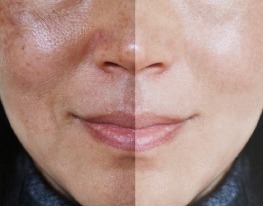About Us


The skin is the largest organ of
the human body. It is the only organ
which is accessible to direct inspection,
by our own unforgiving eyes
and by those of the world.
Melasma
Melasma is a disorder of skin pigmentation, which is characterized by appearance of tan to dark brown patches of pigmentation on the face. They mostly appear over both cheeks, but can be seen on the nose, forehead and/or upper lip as well. This condition is more common in women of darker races like Indians, other Asians, Middle- Easterners and Hispanics. Only 10% of those affected are men. These patches appear darker in summers and can partially fade away during winters.
The Precise Cause Of Melasma Is Not Known.
A lot of men and women with melasma know of someone in their immediate family who also has similar dark patches.
Melasma is more common in women who are in their reproductive years, unlike ‘liver spots’ which are more common after menopause. Changes in hormonal status can definitely influence the appearance of melasma. For instance, chloasma (a variety of melasma) appears during pregnancy, and has been referred to as the ‘mask of pregnancy’. In most cases, chloasma disappears completely within 6 months of the delivery, when the hormonal fluctuations settle down. Similarly, melasma can appear due to hormonal changes influenced by birth control pills. However, hormone replacement therapy (HRT) used after menopause has not been shown to cause the condition.
Melasma has also been found to occur among patients using certain sunlight- sensitizing medications (eg, antibiotics like Rifampicin, certain medications used to treat ovarian and thyroid disorders). There are certain cosmetics as well which can be sunlight- sensitizing.
Melasma is also more frequent along those who spend a lot of time in outdoor occupations and hobbies. This is because people of darker races have more active melanocytes in their skin. When these melanocytes are stimulated by sunlight, especially in the ‘convex’ areas of our face, like the cheeks, nose or chin, they produce very large amounts of pigment, which gets deposited as Melasma.
Melasma is not associated with any internal disease or deficiency. It has no complications other than the fact that it is cosmetically unsightly.
Melasma is diagnosed by its typical appearance. Your dermatologist might decide to perform a Wood’s lamp test to ascertain the depth of the pigment and to rule out other disorders like unusual birthmarks.
Although there is no cure for melasma, there are plenty of treatment options available today, which can fade away the excess pigment to give a more natural and even appearance.
Sunscreens are essential in the treatment of melasma, and they will have to be used life-long as melasma tends to recur every summer. A broad spectrum sunscreen with SPF 30 or higher is ideal. They have to be used every day, irrespective of the weather or your activity. Any cosmetic which irritates the skin must be discontinued. Your dermatologist can help you choose cosmetics which are safe for you.
Melasma can be faded away with skin lightening creams like hydroquinone or kojic acid. Our facility also offers oral medication, chemical peels and laser therapy, for more aggressive treatment of melasma. We caution you against non-physicians claiming to treat melasma with the above-mentioned treatments, as these procedures can cause severe complications at the hands of untrained and unsupervised individuals. Do NOT self medicate with steroid containing creams purchased at the recommendation of a friend or Homeopath or the local Pharmacist. Laser treatments are also not a wise choice for every case of Melasma. Treatment of melasma requires a comprehensive, professional and step-wise approach by an experienced dermatologist. Melasma cannot be faded away in days. It will take at least 2-3 months of regular therapy to obtain appreciable results. Some patients may require chemical peels at periodic intervals (every 3-4 months), to keep their Melasma at bay for years to come. Camouflage make-up is an excellent choice as well, to hide your pigmentation, until treatment shows effect.
